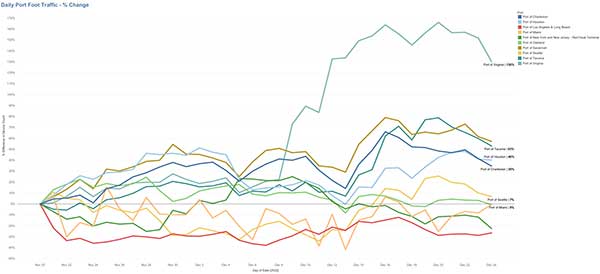The importance of near real-time data as importers increasingly favor East Coast over West.
By: Jeff White, Founder and CEO, Gravy Analytics
The pandemic has disrupted global supply chains, impacting economies and societies worldwide. The U.S. has been particularly affected, with changes in operations and logistics at the nation’s ports having significant ripple effects across the entire supply chain. As the country moves forward post-pandemic, it’s clear that the U.S. supply chain landscape has undergone significant and possibly permanent changes, with more and more importers opting for East Coast ports instead of the once-dominant West Coast. Why are shippers and cargo carriers making this change and what can businesses do to adapt to the new landscape to remain competitive?
In recent years, there has been a significant shift in the route goods take to reach U.S. ports. For more than two decades, the Port of Los Angeles had been the busiest container port in North America, but this has changed as shippers and cargo carriers have opted to move their trade to the East Coast. This move was prompted by a variety of factors, including unresolved negotiations between thousands of dockworkers at West Coast ports and their employers. In addition, California’s Assembly Bill 5 (AB5), which changed the employee classification of truck drivers, resulted in protests by truckers at major ports in California, including Los Angeles, Long Beach, and Oakland, disrupting cargo movement at these ports.
The shift toward East Coast ports gained further momentum during the 2021 holiday shopping season, as goods were left stranded off the coast of California, waiting for weeks to offload at the Ports of Los Angeles and Long Beach. This caused significant frustration for retailers who were unable to offer key products to meet consumer demand during the holiday season. This major bottleneck also caused delayed deliveries to consumers and higher prices for certain goods as demand outpaced supply. This situation made it clear to many shippers and cargo carriers that they could no longer afford to rely solely on West Coast ports, driving them to consider the use of other U.S. ports that would enable faster and more cost-effective delivery options to consumers.

At Gravy Analytics, we’ve seen this shift in traffic from West Coast to East Coast illustrated through our location analytics. We analyzed a sample of foot traffic data at major U.S. ports from November 20 through December 24, 2022, that showed that the Ports of Los Angeles and Long Beach experienced the largest decrease in foot traffic as the holidays approached, while the Port of Virginia saw one of the highest increases. Furthermore, other ports on the East Coast, such as those in Savannah and Charleston, also experienced an uptick in foot traffic during the timeframe analyzed. These findings are indicative of the broader pattern of reduced activity at ports on the West Coast and increased activity at those on the East Coast.
While it’s difficult to predict with certainty what the future holds, it’s safe to say that this shift in the U.S. supply chain will continue to impact the industry. The Port of Los Angeles and the Port of Long Beach will have to work harder to regain its lost trade, and the East Coast ports will have to be ready to handle the increased traffic.
In the dynamic and fast-moving world of international logistics and the global supply chain, it’s critical that businesses have accurate and timely data to inform their business decisions. Near real-time data like location analytics can be especially valuable to shippers and cargo carriers when deciding on which ports to utilize. For example, by using location analytics to monitor foot traffic at major U.S. ports, shippers and cargo carriers can identify which ports are experiencing increased activity and adjust their shipping routes accordingly.
Furthermore, near real-time data can be used to optimize supply chain logistics, from improving inventory management to reducing transit times and costs. For instance, location analytics can help identify the most efficient shipping routes, optimize transportation modes, and predict potential bottlenecks in the supply chain.
The recent shift in U.S. port activity highlights the importance of data and analytics in the global supply chain. By leveraging the latest technology and tools, companies can gain valuable insights into trends and changes in consumer demand, optimize their logistics, and stay ahead of the competition in a rapidly changing market.
About the Author:
Jeff White is the Founder and Chief Executive Officer of Gravy Analytics (gravyanalytics.com).
Prior to founding Gravy, he founded several companies and led them to successful exits. These companies include mySBX (sold to Deltek in 2009) and Blue Canopy (sold to a private investment firm in 2007). Jeff has over two decades of experience leading successful companies and was awarded the D.C. Technology Entrepreneur of the Year in 2011. As the Founder of mySBX, he leveraged the latest web and social media technologies to build an award-winning platform that grew 100% year over year. As the Founder of Blue Canopy, Jeff led the company to receive two Inc. 500 awards for being one of the Top 500 Fastest Growing Private Companies in America, with the lowest growth year being 98%.
Jeff is passionate about building real products for real people and loves to start with a blank canvas (or whiteboard). He strives to never “fall in love” with his creations by balancing them with honest user and customer feedback.
Scott Ellyson, CEO of East West Manufacturing, brings decades of global manufacturing and supply chain leadership to the conversation. In this episode, he shares practical insights on scaling operations, navigating complexity, and building resilient manufacturing networks in an increasingly connected world.